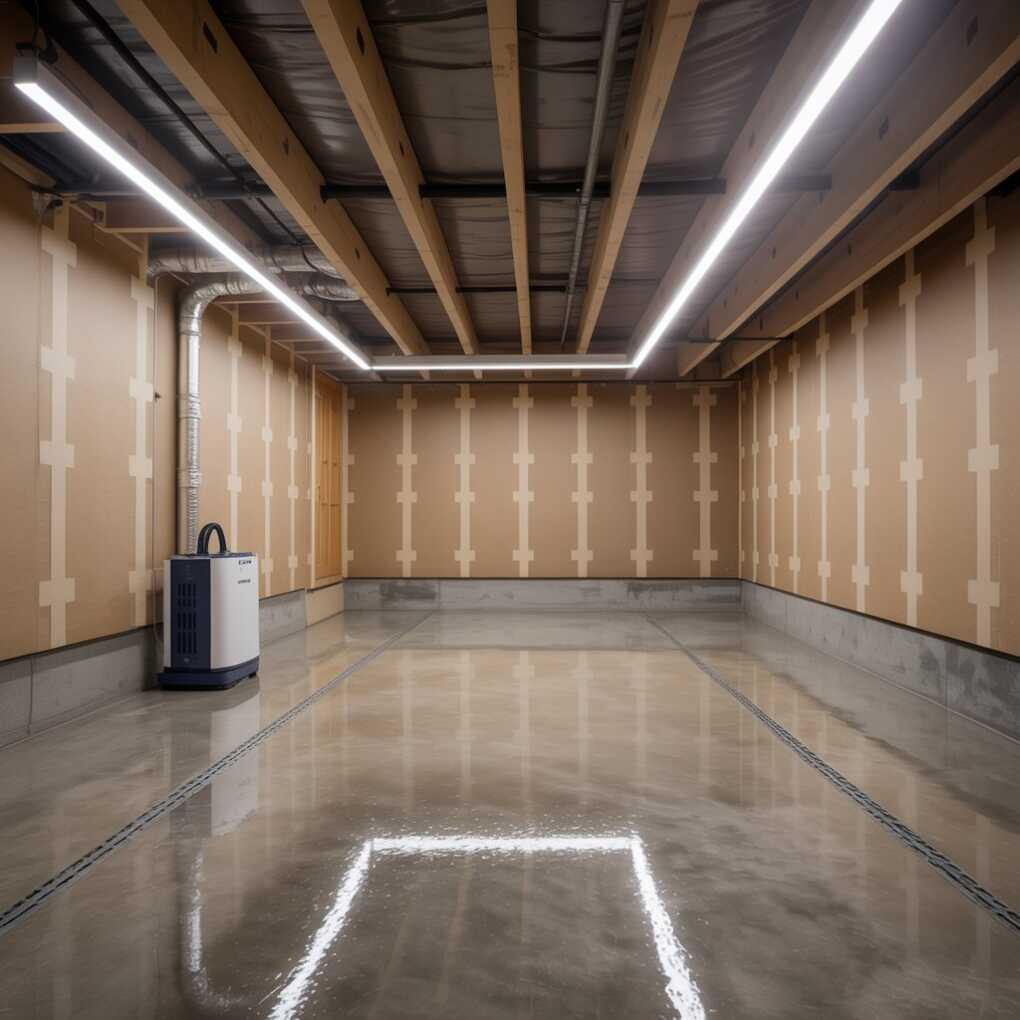Picture this: you’ve just finished transforming your basement into a cozy family room with plush furniture, custom built-ins, and that perfect shade of paint on the walls. Then, after one heavy rainstorm, you walk downstairs to find water pooling across your new flooring and your carefully curated space in ruins. This nightmare scenario plays out in thousands of homes every year, but it doesn’t have to be yours.
Basements are naturally vulnerable to moisture issues due to their below-grade location, but homeowners shouldn’t have to choose between style and protection. The key is understanding that water-resistant design isn’t about sacrificing aesthetics—it’s about making smart choices that keep your investment safe while creating a beautiful space you’ll love for years to come. With expert guidance from professionals like Relief Remediation, who specialize in water damage restoration in Marietta, GA, you can design a basement that’s both stunning and resilient.

Understanding Basement Water Challenges
Basements face unique moisture challenges that make them particularly vulnerable. Common sources include groundwater seepage through foundation walls, condensation from temperature differences, plumbing leaks from aging pipes, and seasonal flooding during heavy rains. The hidden costs of water damage extend far beyond visible destruction—structural deterioration, mold growth, and compromised air quality can plague homes for years.
Georgia’s humid climate particularly compounds basement moisture issues. The combination of high humidity levels and sudden severe weather creates the perfect storm for water intrusion. According to industry data, nearly 98% of basements will experience some form of water damage during their lifetime, with the average basement cleanup service costing homeowners between $3,000 and $10,000. However, smart design choices made during initial construction or renovation can prevent these costly problems entirely.
Foundation & Structural Protection
Idea #1: Install a Proper Drainage System Before You Decorate
Before selecting paint colors or furniture, ensure your basement has robust drainage infrastructure. French drains and sump pumps work as invisible protectors, channeling water away from your foundation before it becomes a problem. When planning your floor layout, coordinate drain placement with your design vision—position sump pump basins in utility closets or behind decorative screens. Professional experts emphasize that proper drainage is your first line of defense, making it essential to work with contractors before adding finishing touches.
Idea #2: Seal and Waterproof Walls Like a Pro
Modern waterproofing technology has advanced dramatically, offering solutions that don’t compromise aesthetics. Interior waterproofing membranes can be applied directly to walls before finishing, while exterior excavation and sealing provide the most comprehensive protection. Consider moisture-resistant paint finishes in semi-gloss or satin that not only resist moisture but also reflect light beautifully, making your basement feel brighter and more spacious. Relief Remediation’s moisture detection services can identify problem areas before you invest in finishes.
Idea #3: Choose Elevated Flooring Solutions
Traditional carpet and hardwood are basement enemies, trapping moisture and harboring mold. Instead, opt for raised subfloor systems that allow air circulation beneath your finished floor. Floating floor options like luxury vinyl plank, engineered wood, or porcelain tile offer stunning visual appeal while resisting water damage. These modern materials create sleek, contemporary spaces with built-in protection—a win-win for design and durability.
Material Selection for Style & Durability
Idea #4: Select Water-Resistant Wall Finishes
Moisture-resistant drywall and cement board provide the foundation for beautiful walls that withstand humidity. Layer on stylish alternatives like textured vinyl wallpaper, decorative tile wainscoting, or modern PVC panels that mimic wood or stone. Choose paint with mold inhibitors in colors that enhance your basement’s natural lighting—lighter shades reflect available light while darker accent walls create sophisticated focal points.
Idea #5: Opt for Waterproof Flooring That Looks Luxurious
Today’s waterproof flooring options rival traditional materials in beauty while far surpassing them in performance. Luxury vinyl tile replicates authentic wood grain and natural stone patterns with remarkable accuracy. Polished concrete floors offer industrial-chic appeal with endless decorative possibilities through staining and scoring. Porcelain tile continues trending in large-format planks that create seamless, elegant spaces. Each option provides superior water resistance while delivering the aesthetic you desire.
Idea #6: Choose Furniture with Water Damage in Mind
Select furniture constructed from metal, plastic, and synthetic materials rather than solid wood. Pieces with elevated legs prevent direct floor contact, allowing air circulation and protecting against minor water incidents. Incorporate stylish storage solutions that keep belongings off the floor—floating shelves, wall-mounted cabinets, and raised storage ottomans serve double duty as functional decor. Industrial, modern, and coastal design styles naturally incorporate these water-resistant materials, creating cohesive looks that prioritize protection.
Climate Control & Air Quality
Idea #7: Install a High-Quality Dehumidification System
Maintaining humidity levels between 30-50% prevents mold growth and protects finishes. Whole-house dehumidifiers integrate with HVAC systems for comprehensive control, while portable units offer flexible solutions for smaller spaces. Hide dehumidifiers inside custom-built-in cabinetry that doubles as attractive storage—your guests will never know protective equipment lurks behind those stylish doors. This proactive approach prevents the need for emergency basement flooding cleanup by controlling moisture before problems develop.
Idea #8: Design for Proper Ventilation and Airflow
Strategic air vent and return placement ensures adequate circulation throughout your basement. Work with HVAC professionals to optimize airflow patterns that prevent stagnant, humid pockets. Install properly sized windows that meet egress requirements while providing natural ventilation and emergency exits. Decorative ceiling fans add visual interest while actively circulating air, preventing the musty odors that plague poorly ventilated basements.
Smart Design Features & Maintenance
Idea #9-12: Emergency Preparedness Meets Style
Integrate smart water leak detectors into your design—modern sensors are small, attractive, and provide instant alerts to your smartphone. Position floor drains strategically in utility and laundry areas, surrounding them with attractive tile work that complements your overall design. Install battery backup sump pump systems that continue operating during power outages, when flooding risk peaks. Create entertainment zones away from potential water entry points, protecting expensive electronics and furnishings.
Keeping Your Investment Protected
Regular maintenance preserves both protection and beauty. Conduct quarterly moisture checks, test sump pumps seasonally, and service dehumidifiers according to manufacturer recommendations. Georgia’s climate requires particular attention during spring and fall when temperature fluctuations increase condensation risk. Watch for early warning signs like musty odors, peeling paint, or visible moisture—addressing these immediately prevents major basement cleanup projects.
When issues arise despite preventive measures, Relief Remediation provides 24/7 emergency water damage restoration services throughout Marietta, GA. Our certified team responds rapidly to minimize damage and restore your beautiful space.
Your Beautiful, Protected Basement Awaits
Water-resistant design doesn’t mean sacrificing style—it means making informed choices that protect your investment while creating spaces you love. With basement renovations averaging $20,000-$50,000, these 12 protective design ideas ensure your investment lasts decades, not just until the next storm. Start implementing one or two ideas today, and build a basement that’s as resilient as it is remarkable.
